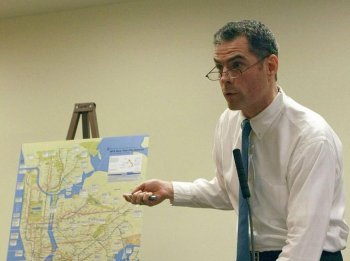NEW YORK—A City Council hearing convened on Wednesday to examine the distribution of Park Enforcement Patrol (PEP) officers across the five boroughs. Manhattan is the borough with the least amount of parkland, but the highest number of officers on patrol.
Manhattan’s parks have the cash—and the safety patrol that comes with it. As crime rises in the city’s parks and the number of patrolling officers decreases, Manhattan’s privately managed parkland has plenty of officers on hand.
Outer boroughs are “getting the short end of the stick,” because they rely on public funds, said Councilwoman Julissa Ferreras of Queens. Private entities, such as Battery Park City Authority, Hudson River Park Trust, and Central Park Conservancy, are drawn to the “sexy” parks of Manhattan, as Councilwoman Melissa Mark-Viverito put it.
“Our communities are sexy, too. It’s just that we’re broke,” joked Ferreras.
Geoffrey Croft, president of New York City Park Advocates , a nonprofit watchdog group, called it a “tale of two cities.” He took the council members on a virtual tour of the city, passing through Battery Park City, where 35 PEP officers patrol 35 acres, and the Bronx, where 8 officers patrol 6,000 acres.
“We as a city are not doing enough,” said Mark-Viverito, who chairs the Committee on Parks and Recreation, adding that publicly managed parks should be just as safe as the privately managed ones.
According to Croft’s count, obtained on Thursday of last week, 40 publicly funded officers patrol 28,000 acres of parkland in New York City: seven in Queens, eight in the Bronx, seven in Brooklyn, five in Staten Island, and 13 in Manhattan.
Deputy Commissioner of Parks and Recreation Liam Kavanaugh provided a higher number, 92, which more than doubled Croft’s count. Croft said Kavanaugh’s numbers include officers stationed in recreation centers, as well as officers on vacation, sick leave, or otherwise occupied but not actually walking through the parks.
Manhattan’s parks have the cash—and the safety patrol that comes with it. As crime rises in the city’s parks and the number of patrolling officers decreases, Manhattan’s privately managed parkland has plenty of officers on hand.
Outer boroughs are “getting the short end of the stick,” because they rely on public funds, said Councilwoman Julissa Ferreras of Queens. Private entities, such as Battery Park City Authority, Hudson River Park Trust, and Central Park Conservancy, are drawn to the “sexy” parks of Manhattan, as Councilwoman Melissa Mark-Viverito put it.
“Our communities are sexy, too. It’s just that we’re broke,” joked Ferreras.
Geoffrey Croft, president of New York City Park Advocates , a nonprofit watchdog group, called it a “tale of two cities.” He took the council members on a virtual tour of the city, passing through Battery Park City, where 35 PEP officers patrol 35 acres, and the Bronx, where 8 officers patrol 6,000 acres.
“We as a city are not doing enough,” said Mark-Viverito, who chairs the Committee on Parks and Recreation, adding that publicly managed parks should be just as safe as the privately managed ones.
According to Croft’s count, obtained on Thursday of last week, 40 publicly funded officers patrol 28,000 acres of parkland in New York City: seven in Queens, eight in the Bronx, seven in Brooklyn, five in Staten Island, and 13 in Manhattan.
Deputy Commissioner of Parks and Recreation Liam Kavanaugh provided a higher number, 92, which more than doubled Croft’s count. Croft said Kavanaugh’s numbers include officers stationed in recreation centers, as well as officers on vacation, sick leave, or otherwise occupied but not actually walking through the parks.







